Octave-Band Four-Beam Antenna Arrays with Stable Beam Direction Fed by Broadband 4 × 4 Butler Matrix
Abstract
:1. Introduction
2. Concept of Octave-Band Four-Beam Antenna Arrays
3. Design and Realization of Octave-Band Four-Beam Antenna Arrays
4. Conclusions
Author Contributions
Funding
Conflicts of Interest
References
- Shelton, J. Reduced sidelobes for Butler-matrix-fed linear arrays. IRE Trans. Antennas Propag. 1969, 17, 645–647. [Google Scholar] [CrossRef]
- Tajik, A.; Alavijeh, A.S.; Fakharzadeh, M. Asymmetrical 4 × 4 Butler matrix and its application for single layer 8 × 8 Butler matrix. IEEE Trans. Antennas Propag. 2019, 67, 5372–5379. [Google Scholar] [CrossRef]
- Zhang, Y.; Li, Y. A Dimension-Reduction Multibeam Antenna Scheme with Dual Integrated Butler Matrix Networks for Low-Complex Massive MIMO Systems. IEEE Antennas Wirel. Propag. Lett. 2020, 19, 1938–1942. [Google Scholar] [CrossRef]
- Lu, R.; Yu, C.; Zhu, Y.; Hong, W. Compact Millimeter-Wave Endfire Dual-Polarized Antenna Array for Low-Cost Multibeam Applications. IEEE Antennas Wirel. Propag. Lett. 2020, 19, 2526–2530. [Google Scholar] [CrossRef]
- Butler, J.; Lowe, R. Beamforming matrix simplifies design of electronically scanned antennas. Electron. Des. 1961, 9, 170–173. [Google Scholar]
- Li, W.-R.; Chu, C.-Y.; Lin, K.-H.; Chang, S.-F. Switched-beam antenna based on modified Butler matrix with low sidelobe level. Electron. Lett. 2004, 40, 290–292. [Google Scholar] [CrossRef]
- Wincza, K.; Gruszczynski, S.; Sachse, K. Reduced sidelobe four-beam antenna array fed by modified Butler matrix. Electron. Lett. 2006, 42, 508–509. [Google Scholar] [CrossRef]
- Denidni, T.; Libar, T. Wide band four-port butler matrix for switched multibeam antenna arrays. In Proceedings of the 14th IEEE Proceedings on Personal, Indoor and Mobile Radio Communications, PIMRC 2003, Beijing, China, 7–10 September 2003; pp. 2461–2464. [Google Scholar]
- Kwang, T.G.; Gardner, P. 4 × 4 Butler matrix beam forming network using novel reduced size branchline coupler. In Proceedings of the 31th European Microwave Conference, London, UK, 24–26 September 2001; pp. 1–4. [Google Scholar]
- Wu, T.; Li, R.; Eom, S.Y.; Lim, K.; Jeon, S.I.; Laskar, J.; Tentzeris, M.M. A multiband/scalable reconfigurable antenna for cognitive radio base stations. In Proceedings of the 2008 IEEE Antennas and Propagation Society International Symposium, San Diego, CA, USA, 5–11 July 2008; pp. 1–4. [Google Scholar]
- Lamanna, M.; Huizing, A. Scalable Multifunction Active Phased Array Systems: From Concept to Implementation. In Proceedings of the IEEE Radar Conference, Verona, NY, USA, 24–27 April 2006; pp. 9–14. [Google Scholar]
- Zhouhai, W.; Xiaolu, W.; Jiaguo, L. Design Considerations of The Active Scalable Array Antenna. In Proceedings of the 2006 CIE International Conference on Radar, Shanghai, China, 16–19 October 2006; pp. 1–4. [Google Scholar]
- Kindt, R.W.; Vouvakis, M.N. Analysis of a wavelength-scaled array (WSA) architecture. IEEE Trans. Antennas Propag. 2010, 58, 2866–2874. [Google Scholar] [CrossRef]
- Cantrell, B.; Rao, J.; Tavik, G.; Dorsey, M.; Krichevsky, V. Wideband array antenna concept. In Proceedings of the IEEE International Radar Conference, Arlington, VA, USA, 9–12 May 2005; pp. 680–684. [Google Scholar]
- Huss, H.G.; Gunnarsson, R.; Andersson, P.; Erickson, R. A wideband, wide angle scan, microstrip array antenna element. In Proceedings of the European Microwave Week, Paris, France, 3–4 October 2005; pp. 275–278. [Google Scholar]
- Holmgren, T.; Ouacha, A.; Samuelsson, C. Ultra Wideband Reconfigurable Beamforming and Beamshaping for Radar and Electronic Warfare Applications. In Proceedings of the 2005 European Microwave Conference, Paris, France, 3–4 October 2005; pp. 251–254. [Google Scholar]
- Wincza, K.; Gruszczynski, S. Broadband Scalable Antenna Arrays with Constant Beamwidths Fed by Frequency-Selective Networks. IEEE Trans. Antennas Propag. 2016, 64, 2936–2943. [Google Scholar] [CrossRef]
- Wincza, K.; Gruszczynski, S. Frequency-Selective Feeding Network Based on Directional Filter for Constant-Beamwidth Scalable Antenna Arrays. IEEE Trans. Antennas Propag. 2017, 65, 4346–4350. [Google Scholar] [CrossRef]
- Gruszczynski, S.; Wincza, K. Broadband 4 × 4 Butler matrices as a connection of symmetrical multisection coupled-line 3-dB directional couplers and phase correction networks. IEEE Trans. Microw. Theory Techn. 2009, 57, 1–9. [Google Scholar] [CrossRef]
- Bona, M.; Manholm, L.; Starski, J.; Svensson, B. Low-loss compact Butler matrix for a microstrip antenna. IEEE Trans. Microw. Theory Tech. 2002, 50, 2069–2075. [Google Scholar] [CrossRef]
- Wincza, K.; Gruszczynski, S.; Sachse, K. Integrated four-beam dual-band antenna array fed by broadband Butler matrix. Electron. Lett. 2007, 43, 7–8. [Google Scholar] [CrossRef]
- Wincza, K.; Staszek, K.; Slomian, I.; Gruszczynski, S. Scalable multibeam antenna arrays fed by dual-band modified Butler matrices. IEEE Trans. Antennas Propag. 2016, 64, 1287–1297. [Google Scholar] [CrossRef]
- Wincza, K.; Staszek, K.; Gruszczynski, S. Broadband multibeam antenna arrays fed by frequency-dependent Butler matrices. IEEE Trans. Antennas Propag. 2017, 65, 4539–4547. [Google Scholar] [CrossRef]
- Staszek, K.; Odrobina, S.; Wincza, K.; Gruszczynski, S. Broadband matrix-type feeding networks for two-beam antennas with constant beamwidth and efficient aperture utilization. J. Electromagn. Waves Appl. 2019, 33, 236–248. [Google Scholar] [CrossRef]
- Staszek, K.; Gruszczynski, S.; Wincza, K. Broadband feeding networks based on directional filters for two-beam antenna arrays. J. Electromagn. Waves Appl. 2019, 34, 1300–1307. [Google Scholar] [CrossRef]
- Zhang, F.; Zhang, F.-S.; Zhao, G.; Lin, C.; Jiao, Y.-C. A Loaded Wideband Linearly Tapered Slot Antenna with Broad Beamwidth. IEEE Antennas Wirel. Propag. Lett. 2011, 10, 79–82. [Google Scholar] [CrossRef]
- Das, S.; Iyer, A.K.; Shaik, L.A.; Saha, C.; Siddiqui, J.Y. Design of a frequency notched coplanar tapered slot antenna using split ring resonator. In Proceedings of the 2015 IEEE Applied Electromagnetics Conference (AEMC), Guwahati, India, 18–21 December 2015; pp. 1–2. [Google Scholar]
- Ebnabbasi, K.; Sczyslo, S.; Mohebbi, M. UWB Performance of Coplanar Tapered Slot Antennas. IEEE Antennas Wirel. Propag. Lett. 2013, 12, 749–752. [Google Scholar] [CrossRef]
- Wang, X.; Laabs, M.; Plettemeier, D.; Kosaka, K.; Matsunaga, Y. 28 GHz multi-beam antenna array based on wideband high-dimension 16 × 16 Butler matrix. In Proceedings of the 13th European Conference on Antennas and Propagation (EuCAP), Krakow, Poland, 31 March–5 April 2019; pp. 1–4. [Google Scholar]
- Wang, Z.; Bo, B.; Yang, F. A multibeam antenna array based on printed Rotman lens. Int. J. Antennas Propag. 2013, 2013, 1–6. [Google Scholar]
- Abadi, S.M.A.M.H.; Behdad, N. Design of Wideband, FSS-Based MultiBeam Antennas Using the Effective Medium Approach. IEEE Trans. Antennas Propag. 2014, 62, 5557–5564. [Google Scholar] [CrossRef]
- Gunnarsson, R.; Ouacha, A.; Huss, L.G.; Samuelsson, C.; Alfredsson, M. A wideband faceted multibeam antenna. In Proceedings of the IEEE International Symposium on Phased Array Systems and Technology, Waltham, MA, USA, 12–15 October 2010; pp. 917–923. [Google Scholar]
- Emadeddin, A.; Salari, M.A.; Zoghi, M.; Darvazehban, A.; Manoochehri, O. A Compact Ultra-Wideband Multibeam Antenna System. IEEE Trans. Antennas Propag. 2017, 66, 125–131. [Google Scholar] [CrossRef]
- Remez, J.; Segal, A.; Shansi, R. Dual-polarized wideband widescan multibeam antenna system from tapered slotline elements array. IEEE Antennas Wirel. Propag. Lett. 2005, 4, 293–296. [Google Scholar] [CrossRef]
- Xian, K.-R.; Chen, F.-C.; Chu, Q.-X.; Lancaster, M. A broadband 3 × 4 Butler matrix and its application in multibeam antenna arrays. IEEE Trans. Antennas Propag. 2019, 67, 7622–7627. [Google Scholar] [CrossRef]




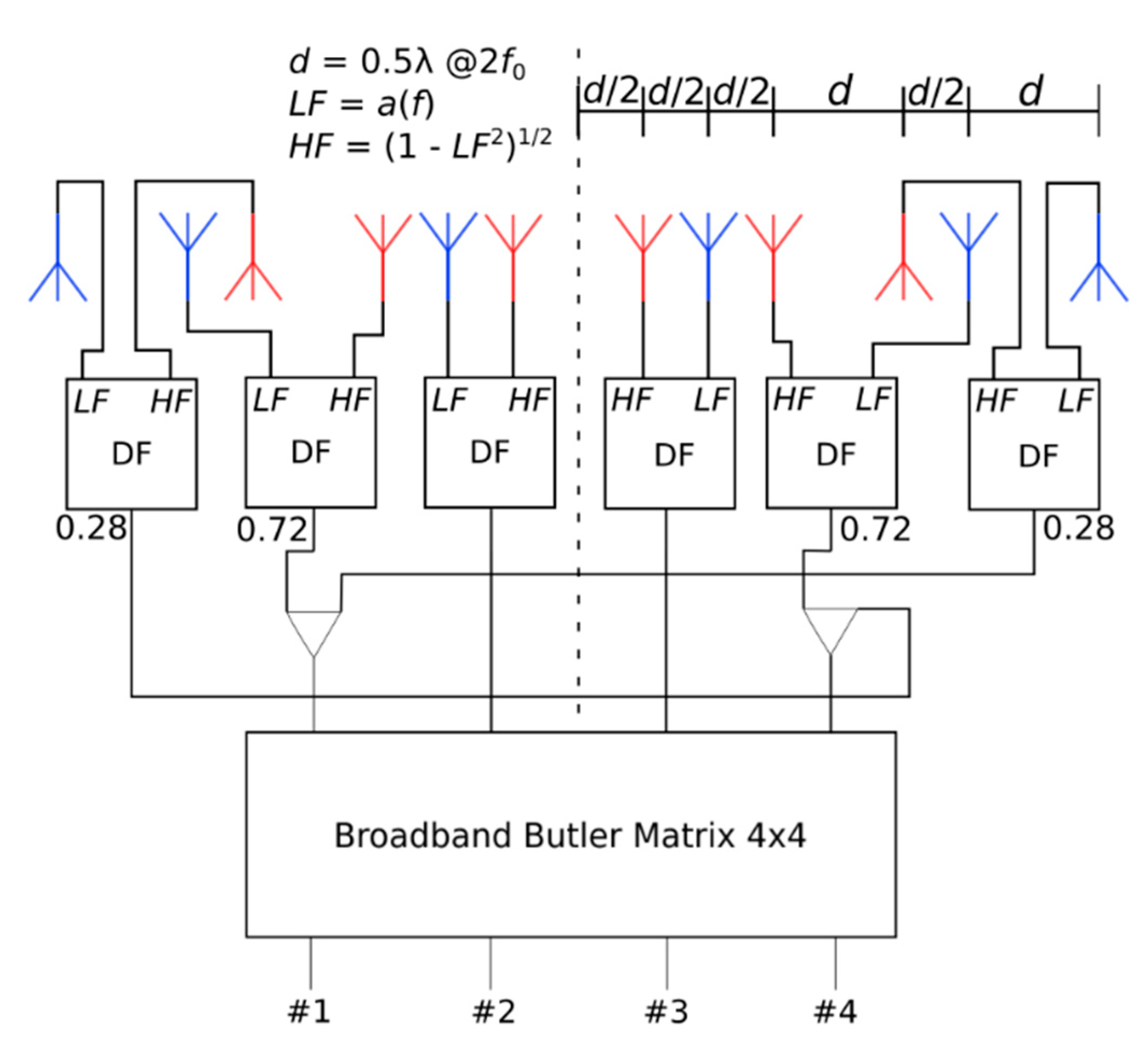
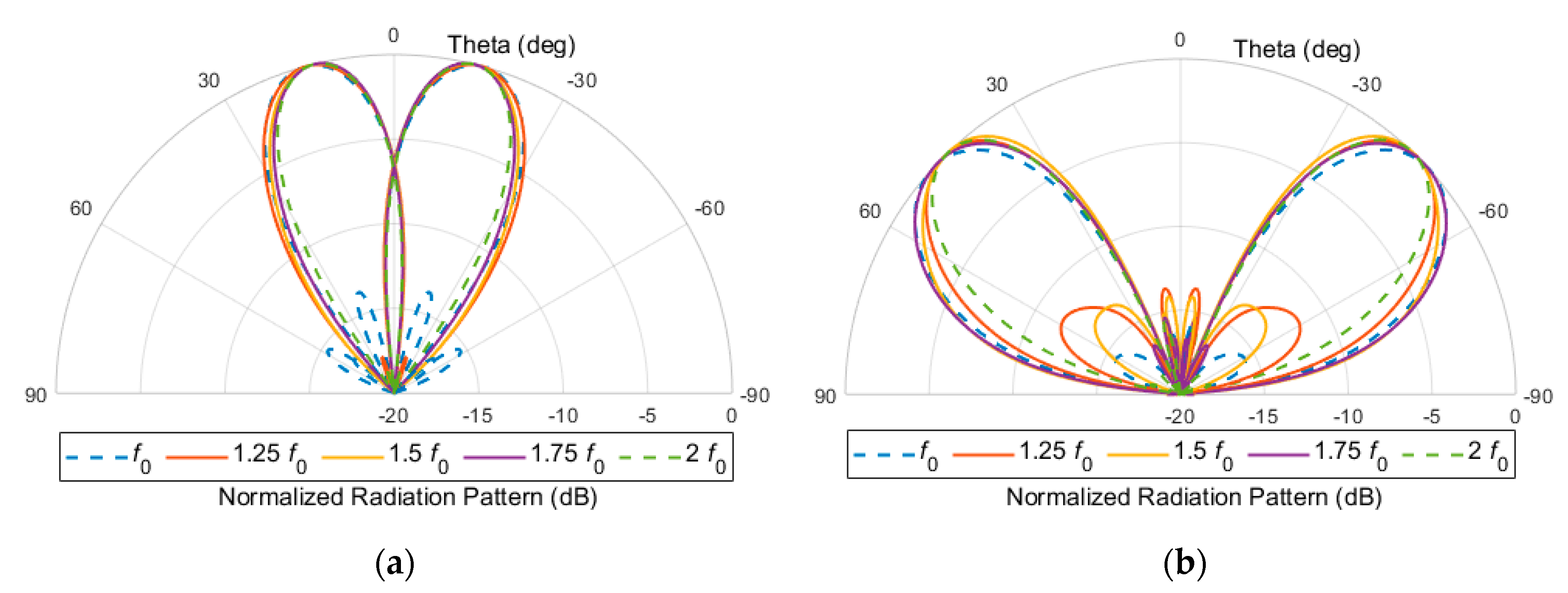
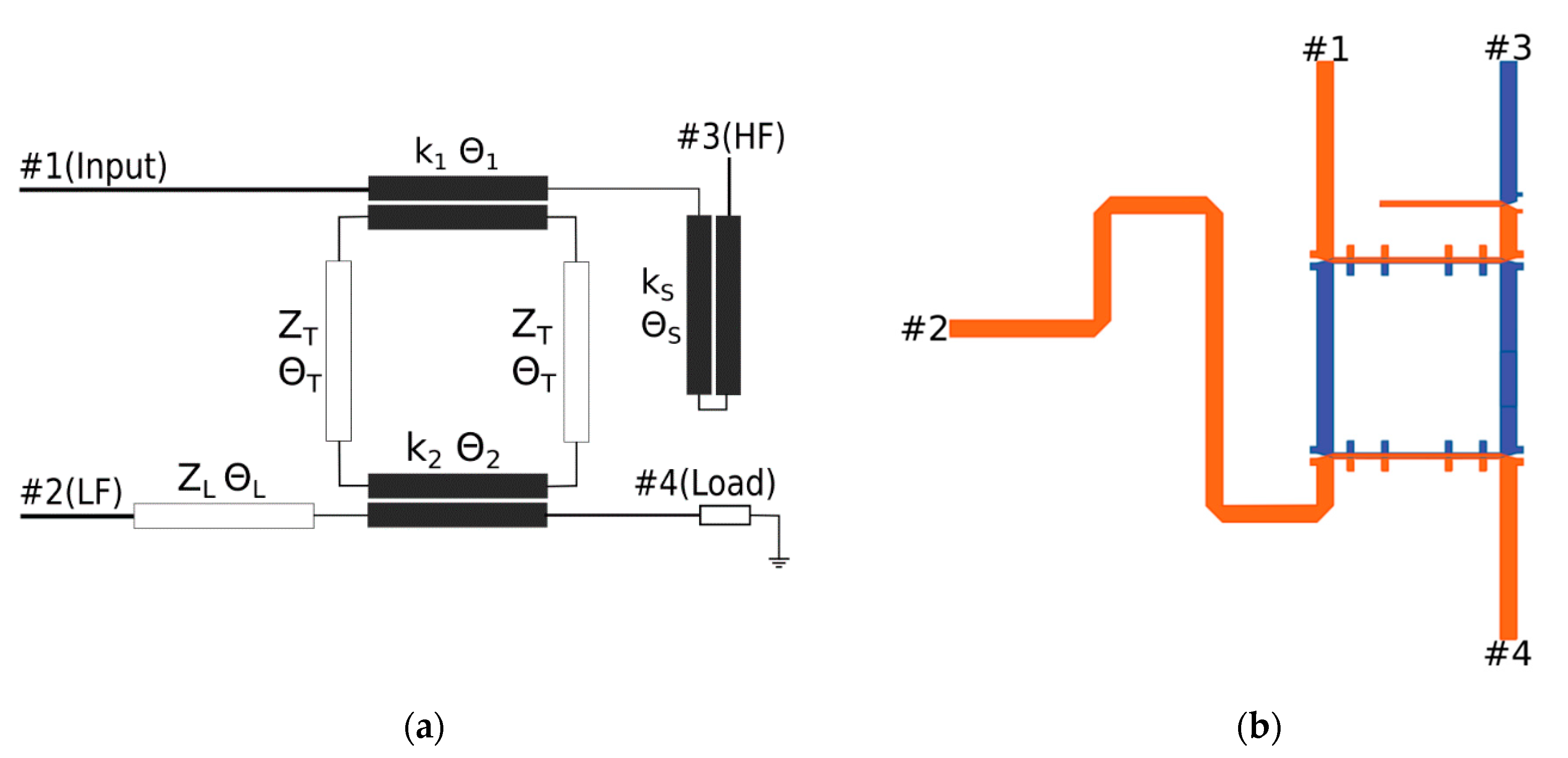
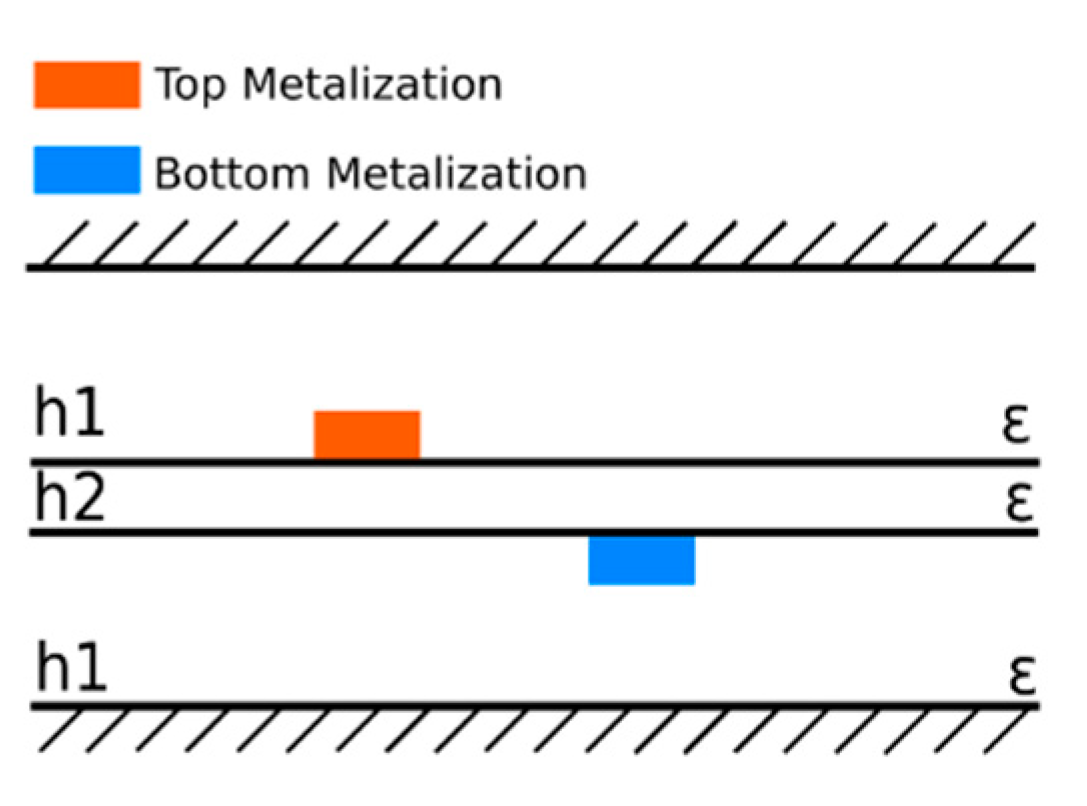

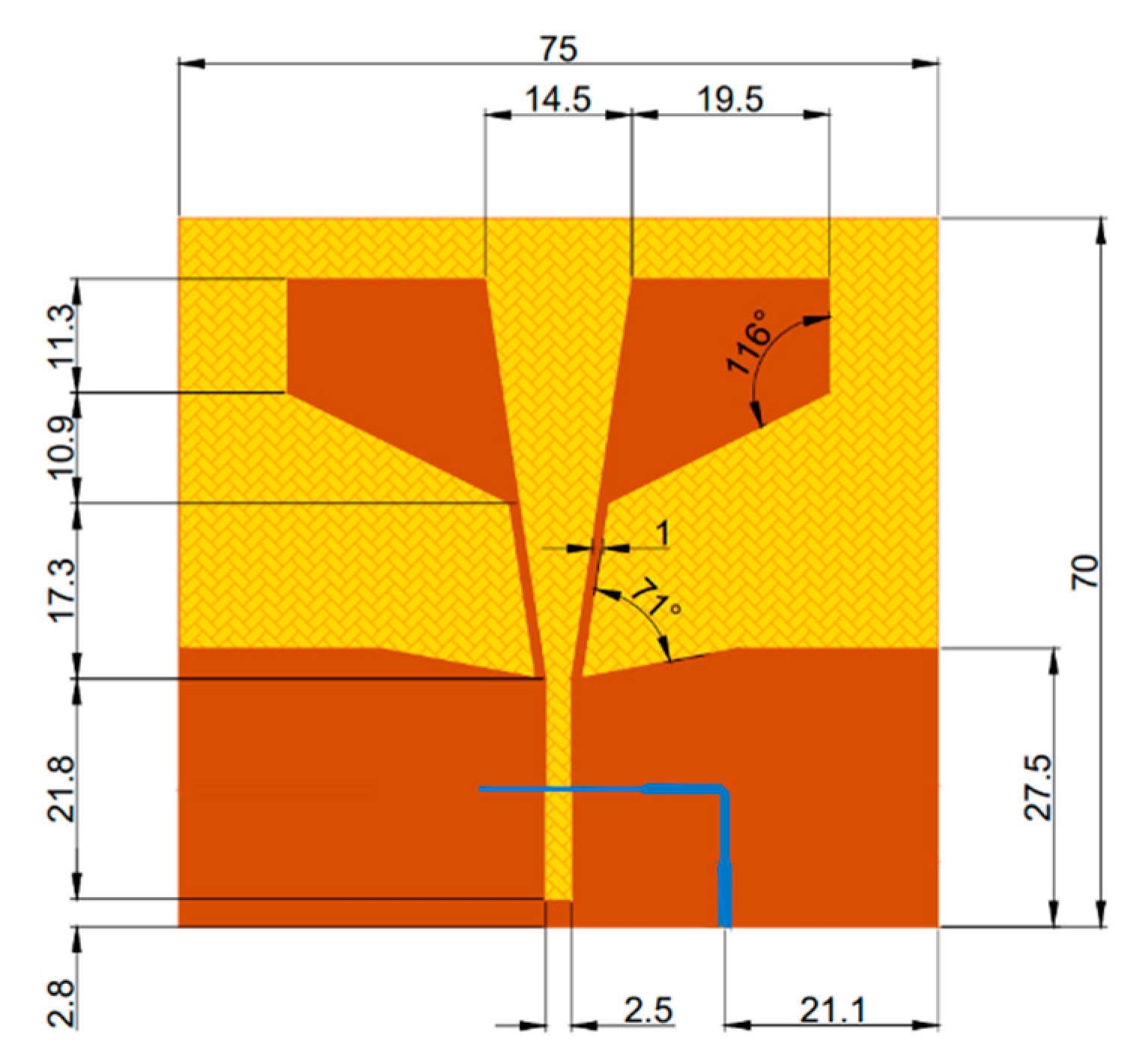
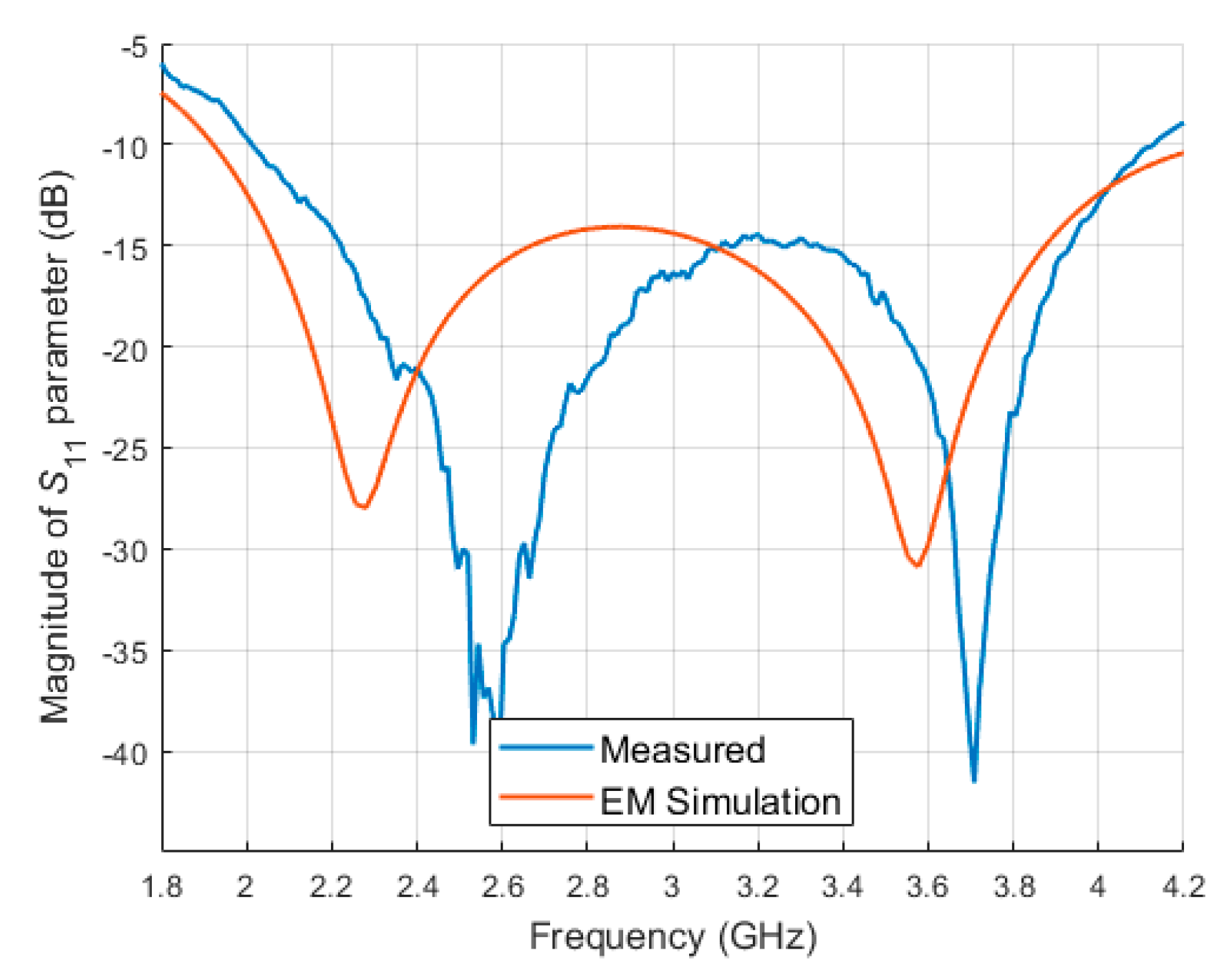
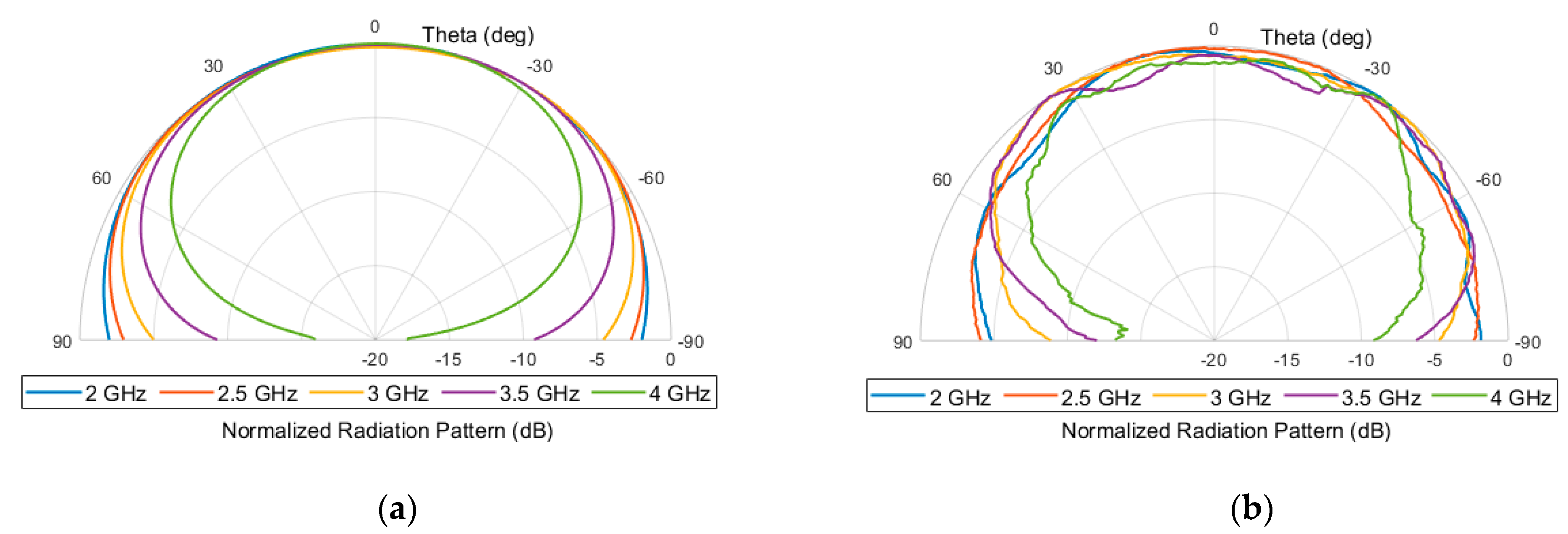

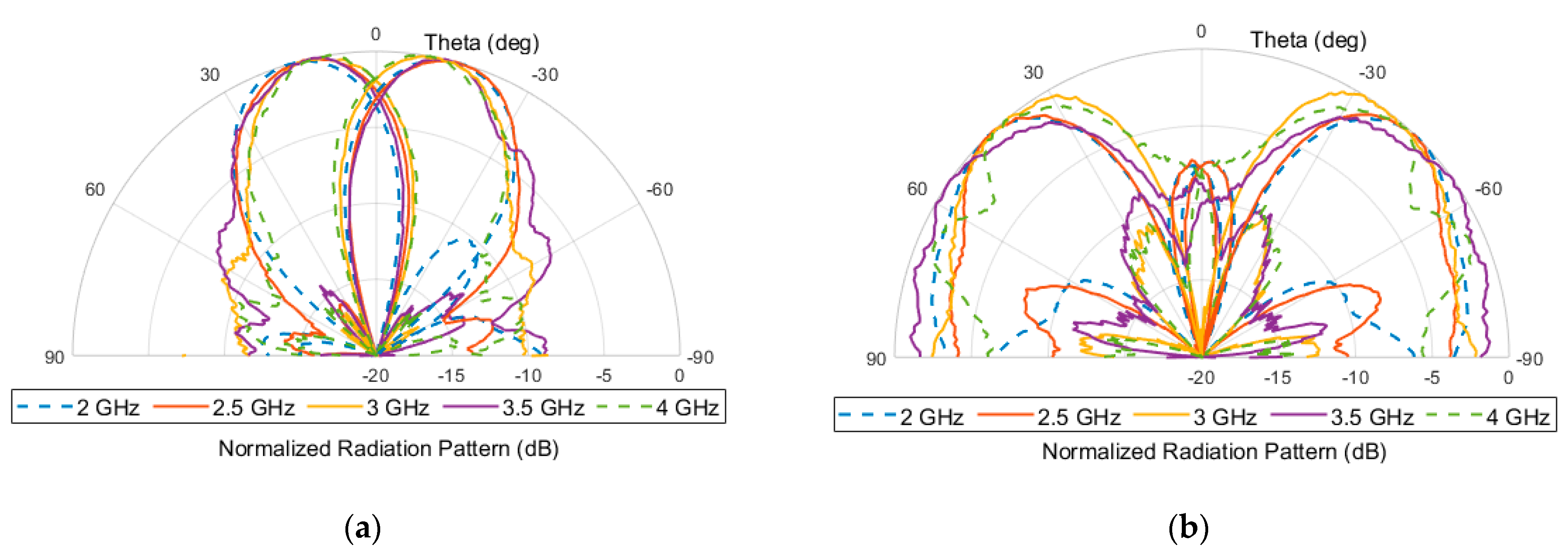
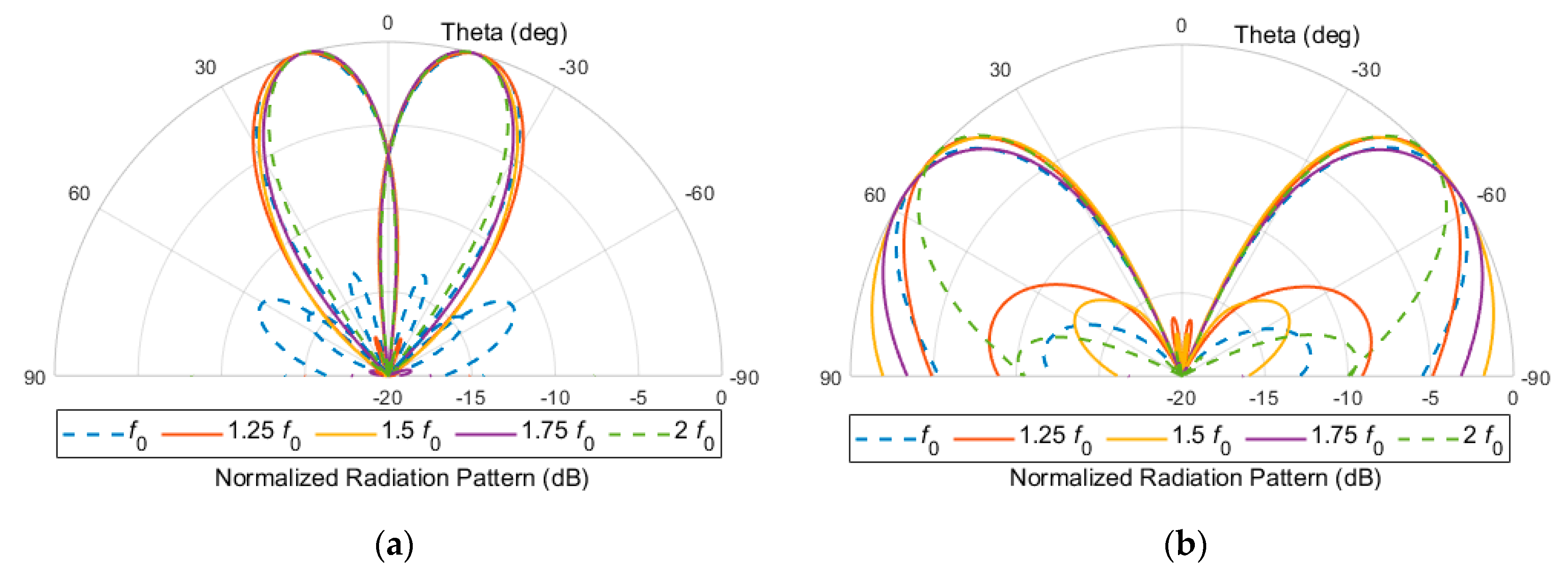

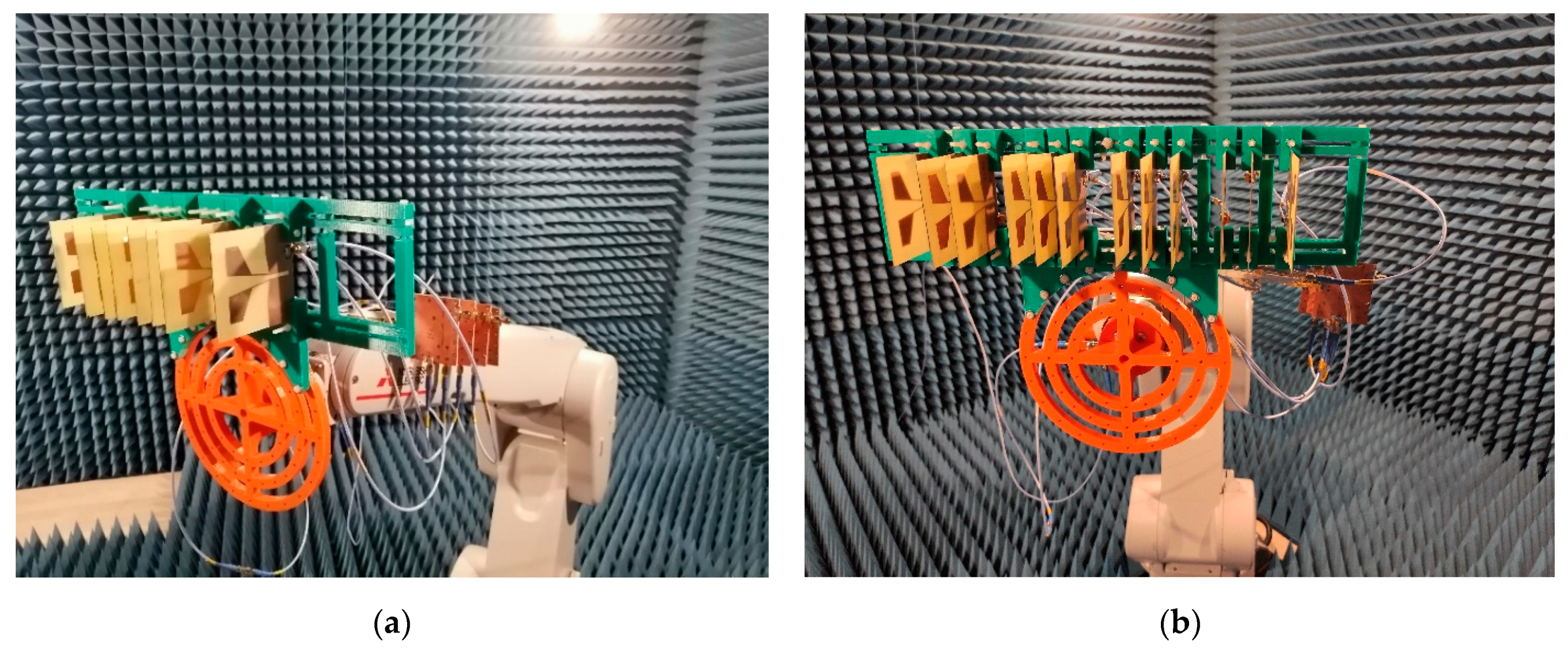
| Parameter | Value |
|---|---|
| k1 | 0.818 |
| k2 | 0.793 |
| kS | 0.784 |
| ZT [Ω] | 50 |
| ZL [Ω] | 50 |
| Θ1 [°] | 90.0 |
| Θ2 [°] | 90.0 |
| ΘS [°] | 59.8 |
| ΘT [°] | 90.0 |
| ΘL [°] | 298.0 |
| Dimension | Value (mm) |
|---|---|
| L1 | 5.8 |
| W1 | 1.195 |
| L2 | 15.6 |
| W2 | 0.8 |
| L3 | 16 |
| W3 | 0.3 |
| Feature | [23] | [25] | [29] | [30] | [31] | [32] | [33] | [34] | [35] | This Work |
|---|---|---|---|---|---|---|---|---|---|---|
| Bandwidth (GHz) | 1.75–3.5 | 1–3 | 25–30 | 12–18 | 8–10 | 5.3–12 | 6–18 | 2.5–7 | 2–4 | 2–4 |
| Bandwidth ratio f2/f1 | 2 | 3 | 1.2 | 1.5 | 1.25 | 2.26 | 3 | 2.8 | 2 | 2 |
| No. of beams | 4 | 2 | 16 | 7 | 4 | 5 | 8 | 9 | 3 | 4 |
| Beamwidth variation | ±4.5° | ±10° | ±3° | N/A | N/A | N/A | ±20° | N/A | ±8° | ±6° |
| Direction variation | ±6.5° | ±6° | ±7° | N/A | N/A | N/A | N/A | N/A | ±10° | ±4° |
| No. of antennas | 8 | 4 | 16 | 8 | 4 | 8 | 8 | 16 | 4 | 8 |
| Complexity | very high | low | very high | medium | very high | high | very high | high | low | low |
Publisher’s Note: MDPI stays neutral with regard to jurisdictional claims in published maps and institutional affiliations. |
© 2021 by the authors. Licensee MDPI, Basel, Switzerland. This article is an open access article distributed under the terms and conditions of the Creative Commons Attribution (CC BY) license (https://creativecommons.org/licenses/by/4.0/).
Share and Cite
Dudek, A.; Kanios, P.; Staszek, K.; Gruszczynski, S.; Wincza, K. Octave-Band Four-Beam Antenna Arrays with Stable Beam Direction Fed by Broadband 4 × 4 Butler Matrix. Electronics 2021, 10, 2712. https://doi.org/10.3390/electronics10212712
Dudek A, Kanios P, Staszek K, Gruszczynski S, Wincza K. Octave-Band Four-Beam Antenna Arrays with Stable Beam Direction Fed by Broadband 4 × 4 Butler Matrix. Electronics. 2021; 10(21):2712. https://doi.org/10.3390/electronics10212712
Chicago/Turabian StyleDudek, Andrzej, Piotr Kanios, Kamil Staszek, Slawomir Gruszczynski, and Krzysztof Wincza. 2021. "Octave-Band Four-Beam Antenna Arrays with Stable Beam Direction Fed by Broadband 4 × 4 Butler Matrix" Electronics 10, no. 21: 2712. https://doi.org/10.3390/electronics10212712
APA StyleDudek, A., Kanios, P., Staszek, K., Gruszczynski, S., & Wincza, K. (2021). Octave-Band Four-Beam Antenna Arrays with Stable Beam Direction Fed by Broadband 4 × 4 Butler Matrix. Electronics, 10(21), 2712. https://doi.org/10.3390/electronics10212712






